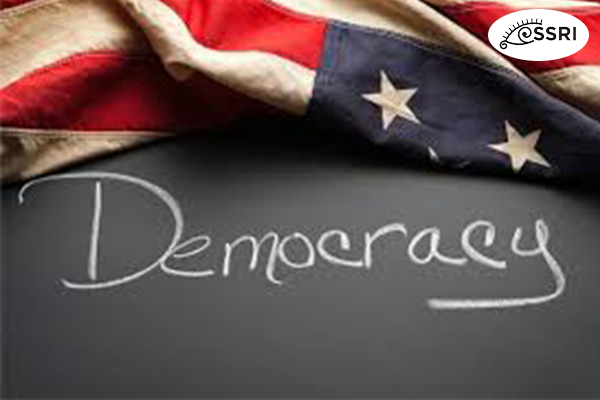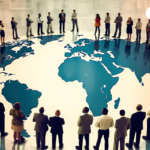Introduction
Democracy is a form of government where citizens participate in decision-making processes. In democratic nations, the populace elects leaders through general elections, entrusting them to represent their interests in policy development. As Monten (2005) notes, the decisions made by these elected officials reflect the will of the people who chose them. Over time, democracy evolves, increasingly granting citizens more rights and influence over governance. However, this progression can also have adverse effects, potentially restricting certain individual freedoms.
In the United States, democracy grants citizens the right to elect their leaders, including the President and members of Congress. Mitchell (2009) argues that democracy functions more effectively in developed countries than in developing ones. In many developing nations, democracy is gradually replacing long-standing authoritarian regimes. Typically, countries with a high Gross Domestic Product (GDP) exhibit stronger democratic practices compared to those with lower GDP.
American democracy is well-established, with the Constitution ensuring freedom of expression. Conversely, in many developing countries, democratic institutions are weak, and citizens have limited influence over national policies. In these nations, governance often features bureaucratic systems where elected leaders may act as dictators. Media in such countries is frequently under government control, restricting freedom of speech.
Goldberg, Wibbels, and Mvukiyehe (2008) distinguish two primary forms of democracy: direct and indirect. In a direct democracy, citizens actively participate in policy formulation. Conversely, indirect democracy involves elected representatives making policy decisions on behalf of the people. In a direct democracy, citizens may be selected through a lottery to make strategic decisions directly. In a representative democracy, elected officials, such as members of Congress, formulate policies reflecting the electorate’s views. This system acknowledges the impracticality of direct governance by a widely dispersed populace.
A key feature of democracy is media freedom. Where the media is government-controlled, democracy is undermined. The media plays a crucial role in the evolution of democracy by educating citizens about their rights, election processes, and freedom of speech. Moreover, the media serves as a communication channel between politicians and the public, enabling citizens to suggest policy changes and participate in decision-making.
The Role of Media in Advancing Democracy
Social networks and other media platforms play a significant role in advancing democracy by providing spaces for citizens to interact with each other and with their leaders, discussing issues that affect the country’s governance. These platforms facilitate direct communication, enabling citizens to make policy suggestions that can be incorporated into the policymaking process, thus giving them a voice in governance.
Carothers (2007) highlights that for a country to be truly democratic, the freedom of the media must be ensured, as it allows citizens to freely express their views. He underscores the necessity of a free media in the progression of democracy. Media outlets like radio, TV, social media, and newspapers are particularly influential in this regard, as they provide platforms for interaction between voters and leaders, allowing citizens to voice their concerns about policies.
These media types are crucial because they educate citizens about their electoral rights and freedoms of speech. In countries where the media is regulated by the government, democracy suffers, as citizens are kept uninformed about governance issues. In contrast, in most developed countries where media is not government-controlled, citizens can actively participate in policy formulation. Voter education, an essential component of democracy, is primarily conducted through the media, highlighting its importance in democratic advancement.
The unrestricted nature of media in developed nations significantly contributes to the growth of democracy in these countries (Wolf, 2014). This paper aims to explore the relationship between media and democracy. To achieve this, it will examine the nature of democracy in the US as portrayed in news articles and academic literature. The essay will include opinions from various politicians and political analysts on the topic of democracy, presenting contrasting views to illustrate the strengths and weaknesses of American democracy as expressed through newspapers.
Democracy in the United States
The United States is widely regarded as one of the most democratic nations globally, characterized by its representative democracy. In this system, citizens elect their leaders through general elections. A fundamental right enshrined in the U.S. Constitution is freedom of speech, allowing every citizen to express their opinions on various national issues (Hazan & Rahat, 2010). This right ensures that media outlets can feature columnists who freely critique the government. Democracy is underpinned by free speech and an unregulated media. Citizens are free to voice their opinions, regardless of their political affiliation, enabling even minority viewpoints to be heard and respected.
The American Constitution guarantees media freedom, with no government interference, solidifying the U.S. as one of the world’s most democratic countries. American democracy began on July 4, 1776, with the signing of the Declaration of Independence (Gore, 2008). This document established the principle of electing the president through a secret ballot. The Obama administration, among others, has worked to advance democracy, defining it as a government run by and for the people.
During the 2012 presidential campaigns, candidates emphasized their commitment to serving the nation’s best interests (Goldman, 2012). Their campaign slogans, broadcasted on local and international media, fostered a sense of civic engagement, encouraging citizens to participate in the policymaking process. Local television networks aired live debates, allowing leaders to outline their strategies and persuade voters.
American leaders highlight the democratic nature of the U.S. through the legislative process for passing a bill into law (McClam, 2014). This process starts with the drafting of a proposed bill, detailing all relevant proposals. The bill is then presented to Congress for debate, during which members can make amendments. Voting on the bill is conducted by secret ballot; if the majority supports it, the bill is sent to the President for approval.
Through these mechanisms, the United States demonstrates its commitment to democratic principles, ensuring that citizens have a voice in governance and that their rights are protected and upheld.
Presidential Authority and Legislative Processes in the US
The President has the authority to either approve a bill into law or reject it. If the President rejects the bill, it is returned to Congress with proposed amendments. Once these amendments are reviewed and discussed, members vote again on the bill. Importantly, the President cannot veto a bill that has been passed by a two-thirds majority in both the House and the Senate. This requirement for presidential assent ensures a system of checks and balances. For instance, the President may veto a bill after consulting with various stakeholders, including lobby groups, which prevents Congress from having unchecked power. Conversely, Congress can limit the President’s power by passing legislation that requires a two-thirds majority, compelling the President to sign it into law (Magen & McFaul, 2009). This mutual oversight ensures that neither branch can dominate the policymaking process, maintaining a balanced democratic system.
The media plays a crucial role in this process by informing and mobilizing the public about prospective bills. It serves as a platform for pressure groups to express their concerns, which can influence the President’s decision on whether to approve or reject a bill.
Additionally, the judiciary, particularly the Supreme Court, has the authority to overturn a bill passed by Congress if it is deemed inconsistent with the Constitution. The Supreme Court can declare such a bill null and void, regardless of presidential approval (Carothers, 2007). This robust judicial review is a key element of the American system of checks and balances.
Every American citizen has the right to challenge a bill in court, seeking amendments or total rejection of its provisions. This ensures that the legislative, executive, and judicial branches work collaboratively to create policies that serve the best interests of the citizens. The ability of each branch to check the others prevents any single branch from overstepping its constitutional boundaries. Furthermore, the right of citizens to challenge legislation in court underscores the democratic nature of the system.
However, O’Donnell (2007) argues that America’s democratic status is compromised by bureaucracy, particularly because other branches of government cannot challenge Supreme Court decisions. The Supreme Court, established by the Constitution as the highest court, issues final verdicts that are not subject to appeal. Judges on the Supreme Court are nominated by the President and confirmed by Congress. If Congress is dominated by the President’s party, the appointees may be biased towards the President’s policies.
This situation can lead to a form of judicial bias, where Congress has little influence over the appointment process due to partisan dominance. Consequently, the President could enact policies that undermine democracy without being challenged in court. Reforming the judicial appointment process to allow public elections of judges, as suggested by Finkel, Pérez-Liñán, and Seligson (2007), could enhance democratic accountability and prevent potential abuses of power.
Bureaucracy and Democracy in the United States
As discussed earlier, democracy is a system of governance where citizens elect their leaders through general elections. Leaders who secure the majority of votes assume leadership positions. However, the appointment of judges by the President contradicts the principles of direct democracy, which emphasize citizens’ rights to elect their leaders.
Another aspect of bureaucracy in the U.S. is evident in the election processes for both the President and members of Congress. While citizens vote through a secret ballot, these elections can favor the majority population, potentially marginalizing non-natives. Racism, a persistent issue in America, often compromises the electoral power of the Black American population, thus undermining democratic principles (Newman & Lake, 2006).
Furthermore, the absence of a strong opposition to critique government policies can lead to bureaucratic dominance. When the President’s party holds the majority in Congress, it becomes difficult for the opposition to check government excesses, fostering conditions for potential dictatorship (Wejnert, 2010). A robust opposition is essential to maintaining democracy by preventing the unchecked passage of government policies.
To mitigate these issues, measures could be implemented to strengthen the opposition. For instance, requiring a two-thirds majority for passing significant legislation, especially those related to human rights and democracy, would ensure broader consensus and reduce the risk of majority dominance. Currently, policies pass by a simple majority, weakening opposition efforts when the government controls Congress. The original Constitution aimed to empower citizens in governance decisions, but amendments over time have deviated from this objective.
Executive power in policy enforcement also contributes to bureaucracy. There have been instances where the executive branch uses excessive force, particularly evident in police actions. Police brutality, often influenced by racial discrimination, undermines democratic values. Recent incidents highlight police aggression towards citizens, especially during protests. According to the American Constitution, citizens have the right to peaceful demonstrations (McClam, 2014). The excessive use of force by police, as government agents, threatens democracy. The government should enact laws to restrict police from using excessive force against suspects to uphold democratic principles.
In conclusion, while the U.S. prides itself on being a democratic nation, several bureaucratic practices challenge this ideal. Strengthening the opposition, ensuring fair representation, and curbing excessive executive force are crucial steps toward reinforcing democracy in the United States.
Evolution of American Democracy
American democracy has significantly evolved since the passage of the Constitution in 1787. These changes have brought about substantial shifts in the country’s policies. One of the most notable amendments concerns the presidential election process. Originally, the Electoral College elected the President from a pool of many candidates (Monten, 2005). In contrast, the current system typically limits the presidential race to two main candidates, often from the two major political parties. This lack of independent candidates is seen by some as undemocratic because it restricts voter choice.
The existing electoral system, where the Electoral College elects the President instead of a direct popular vote, is also criticized for undermining democratic principles. In this process, citizens cast their ballots, but the Electoral College ultimately decides the presidency. A candidate can win the popular vote but lose the election if they do not secure enough Electoral College votes. Thus, the Electoral College is the final arbiter of the presidential election, which many view as a deviation from direct democracy since it limits the direct influence of the electorate..
Conclusion
The United States is widely regarded as one of the most democratic nations in the world, characterized by its commitment to free speech and a free media. The American Constitution guarantees every citizen the right to free speech, underscoring the nation’s dedication to democratic principles. As discussed in this research paper, the media plays a crucial role in advancing democracy by informing and mobilizing the public.
In the US, the three branches of government—executive, legislative, and judicial—work collaboratively in the policy-making process, ensuring a system of checks and balances. Congress enacts laws, which are then sent to the President for approval. The Supreme Court has the power to overturn any laws that conflict with the Constitution. Furthermore, citizens have the right to challenge the legality of laws in court, reinforcing the democratic framework.
Despite these strengths, American democracy faces criticism in certain areas. The electoral process for the presidency, which relies on the Electoral College rather than a direct popular vote, is seen as undemocratic by some. Additionally, the lack of a strong opposition can lead to bureaucratic dominance by the ruling party. These issues, among others, have been thoroughly examined in this paper, highlighting both the strengths and challenges of American democracy.
References
- Carothers, T. (2007). US Democracy Promotion During and After Bush. Washington, DC: Carnegie Endowment for International Peace.
- https://studycorgi.com/us-democracy-and-its-media-representation/
- Finkel, E., Pérez-Liñán, A., & Seligson, M. (2007). The Effects of US Foreign Assistance on Democracy Building, 1990–2003. World Politics, 59(03), 404-439.
- Goldberg, E., Wibbels, E., & Mvukiyehe, E. (2008). Lessons from Strange Cases: Democracy, Development, and the Resource Curse in the US States. Comparative Political Studies, 41(5), 477-514.
- Goldman, R. (2012). Obama Wins Re-election With Romney Defeated in the Key States. ABC News. Web.
- Gore, D. (2008). President Winning Without Popular Vote. Web.
- Hazan, Y., & Rahat, G. (2010). Democracy Within Parties: Candidate Selection Methods and Their Political Consequences. Oxford, UK: OUP Oxford.
- Magen, A., & McFaul, M. (2009). Promoting Democracy and the Rule of Law: American and European Strategies. Basingstoke, UK: Palgrave Macmillan.
- McClam, E. (2014). Obama Speaks on Big Republican Wins in Midterm Election. NBC News. Web.
- Mitchell, L. (2009). Uncertain Democracy: US Foreign Policy and Georgia’s Rose Revolution. University Park, PA: University of Pennsylvania Press.
- Monten, J. (2005). The Roots of the Bush Doctrine: Power, Nationalism, and Democracy Promotion in US Strategy. International Security, 29(4), 112-156.
- Newman, K., & Lake, R. (2006). Democracy, Bureaucracy, and Difference in US Community Development Politics Since 1968. Progress in Human Geography, 30(1), 44-61.
- O’Donnell, G. A. (2007). The Perpetual Crises of Democracy. Journal of Democracy, 18(1), 5-11.
- Wejnert, B. (2010). Democratic Paths and Trends. Bingley, UK: Emerald Group Publishing.
- Wolf, S. (2014). The Generic Congressional Ballot, the US House Popular Vote, and Democratic Legitimacy. Web.




